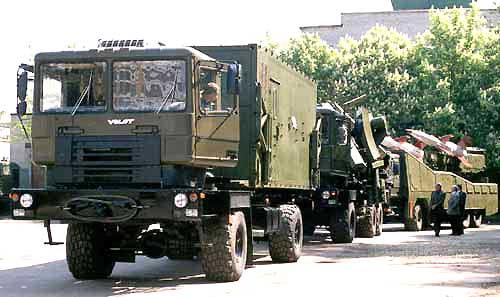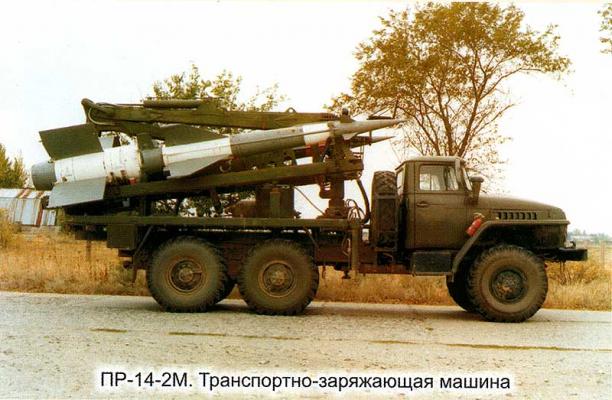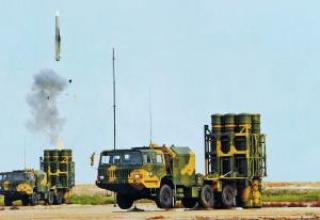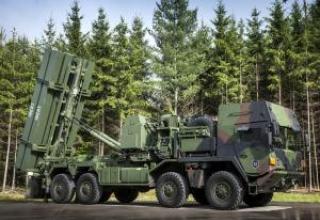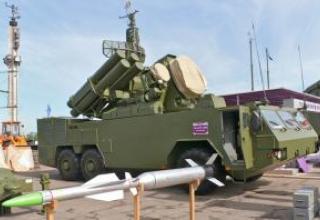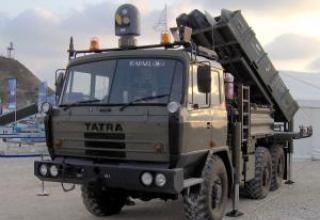For countries that have Soviet S-125 Pechora SAM systems in service. (SAM S-125 "Pechora" entered into service in 1961) Russian financial and industrial group "Defense Systems" offers a deep upgrade of this complex. This project, called "Pechora-2", was created as part of a tender to upgrade the Egyptian S-125 SAM system.
Upgrading of Pechora-1" SAM systems to the level of "Pechora-2" involves improving the characteristics of the complex, ensuring the successful fight against modern means of air attack in a complex interfering environment through the use of technology and the element base of SAM S-300PMU1.
Pechora-2" SAM system provides an effective fight against low-flying and small targets. The introduction of anti-interference devices ensures the detection, tracking and firing of targets under the influence of all types of radio interference. The new tele-optical system allows detecting and tracking targets in the infrared range. Doubling the number of launchers increases the firepower of the system. Installation of the system's fixed assets on the chassis increases the system's mobility.
Kuntsevo Design Bureau, Fakel Design Bureau, Central Design Bureau Almaz, Moscow Radio Engineering Plant, State Unitary Enterprise Special Machine Building Design Bureau and a number of other Russian and Belarusian organizations were involved in the works.
Composition:
The system consists of the following fixed assets.
- The radar of detection of "Casta-2E2";
- one or two radars of escort and guidance;
- the control cabin of UNK (UNK-M);
- up to eight launchers with two missiles each;
- power supply and technical support facilities.
Launch of the rocket - inclined, with the launcher facing the corner of the place and azimuth. Missile flight control and pointing at the target is carried out via radio commands received from the ground-based guidance radar, while detonation of a combat unit on command from a radio detonator when approaching the target at the required distance or from the guidance station.
Upgrading of the initial complex C-125 to the level of "Pechora-2" provides:
- Creation of a new self-propelled launcher 5П73-2М on the modified MZKT-6525 chassis with increased cross-country ability and 6x6 wheel arrangement.
- Replacement of the next analogue equipment of the complex with digital one:
- coordinate determination devices (CCD);
- control command generation devices (UVK);
- devices for selection of moving targets (MTS);
- automated start device (AST);
- devices of low altitude (MW);
- training and control equipment;
- Interference demodulation devices (ICS);
- synchronizer devices.
- Introduction of new protection means against active and passive radio interference.
- Introduction of autocapture and target tracking devices into the TV channel.
- Introduction of a device providing special space scanning methods.
- Modernization of the missile using a new launch engine, combat unit and radio detonator for optimal detonation of the BC taking into account the directional pattern of the detonator and the field of flight of fragments.
- Transition from towed cabins to car chassis.
The starter unit 5П73-2М has six driving wheels with variable pressure tires. The power unit is a V-shaped eight-cylinder diesel engine YAMZ-238D with an output of 330 hp. The tire pressure is regulated by a switch installed in the cabin. The starter unit has an integrated power supply system and the minimum time of deployment at an unprepared starting position. Standard towable PU 5P73 without two outer rails is used for manufacturing of the art part. Self-propelled PU is transported in a loaded state, with two missiles, which greatly simplifies its preparation for combat operations. Communication of the booster with the control cabin can be carried out via wireline or telcode radio. Modernization of the booster unit also involves replacing its electrical equipment with a modern element base.
A new transport and charging machine PR-14-2M equipped with a hydraulic manipulator for charging and discharging by crane method is introduced into the starting battery, which more fully meets the conditions of work at an unprepared site (see photo).
During the modernization, 44 blocks and 6 cabinets are removed from the equipment of the cabin UNK (UNK-M) and two cabinets with digital equipment UK360, UK370 are introduced again. In an individual set of ZIP introduced nodes and elements that provide the work of the newly introduced equipment. Delivered together with the PIP equipment is 50% of the equipment volume. Introduction of highly reliable equipment on modern technological and element base increases reliability and durability of the complex.
NEW WARFARE AND MAINTENANCE CAPABILITIES
- Modernization provides for the introduction of the mode of target acquisition automation, displaying information about the parameters of target movement and the boundaries of the target area on the guidance operator's workstation screen (RM), which simplifies the combat calculation algorithm and reduces the working time of the complex, the guidance operator's screen displays the "Formula" of the guidance station operation containing the following information
- the current value of target AZIMUT (beta) in degrees;
- the current value of the target Epsilon angle of view in degrees;
- angularity to the target (E) in km with an accuracy of 0.1 km;
- Target height (H) in km with an accuracy of 0.1km;
- Target speed (V) in m/s accurate to 1m/s;
- Target PARAMETER (P) in km with an accuracy of 0.1 km.
- The target area (inclined range) is also shown with special icons:
- the far limit of the kill zone;
- the nearest boundary of the kill zone;
- the meeting point at the time of missile launch;
- the guaranteed area of engagement.
- After the launch of the missile in the "Formula" on the place of information about the angle of the place appears information about the deviation of the missile from the designated trajectory, and at the point of meeting the miss is fixed in meters.
- The target acquisition zone and the probability of hitting the target are increased in the station operation mode without interference and under the influence of intensive radio interference due to the increase in accuracy of target tracking, optimization of signal processing methods, reduction of fluctuations errors and elimination of drifts of "zeros". Noise immunity of the complex from various types of active and passive radio interference, as well as from the underlying surface due to the use of new methods of protection against interference and signal processing methods.
- Due to the introduction of navigation system and telecode communication, automatic target designation reception from any external radar information sources is provided;
- The capabilities of the complex with the use of a tele-optical visier are being expanded by introducing the equipment of auto capture and auto tracking of the target and high accuracy of its coordinates in this mode.
- It is possible to warn about the appearance of the target by introducing an audible target indication device.
- It is possible to follow the target by extended coordinates in case of temporary information loss in radar and tele-optical tracking modes.
- Introduction of the digital simulator provides imitation of complex air situation, different variants of attack, different types and methods of influence of radio interference, which allows improving the quality of preparation and training of combat calculations of the complex.
- Introduction of the self-control equipment and auto troubleshooting in the newly introduced equipment, introduction of new types of replacement elements facilitates the work of calculations on checking and preparation of equipment for combat work, reduces the time of troubleshooting.
- The introduction of highly stable equipment with a small number of adjustable parameters, the removal of a significant amount of analogue equipment can reduce by 2-2.5 times the volume and time for routine work. At the same time, the work of the maintenance personnel of the station is simplified. Energy consumption of the station with new equipment is reduced by 30%.
- Introduction of the digital equipment of the start-up device reduces the time of preparation of initial data, increases the accuracy of calculation of the affected zone boundaries.
Characteristics:
| Feature | "Pechora" | "Pechora 2" |
| Defeat zones | ||
| Altitude range, km | 0.02-18 | 0.02-20 |
| Maximum range at an altitude of 0.5 km | 11km | 18-20 km |
| Maximum range at an altitude of 6 km | 17 km | 25 km |
| Maximum range at an altitude of 14-20 km | 18 km | 28 km |
| Maximum parameter,km | 16 | 24 |
| Probability of hitting the target with one missile | ||
| * at a range of 25 km | 0.5 | 0.72-0.99 |
| * at a range of 25-28 km | - | 0.51-0.99 |
| Noise immunity characteristics | ||
| Interference that takes you around the corner: | ||
| * escort angular errors (with GSN) | 2'-3' | 1'-1.5' |
| * escort angular errors (no GSH) | 5'-10' | 1'-1.5' |
| Breeding of moving targets | ||
| *Corneral target tracking errors in the background of reflections from local objects and passive interference | 3'-5' | 1'-2' |
| *" Angular target tracking errors in "MV" " | up to 10' | 3'-4' |
| * rollover of target tracking against the background of reflections from local objects | no | yes |
| * worked in ASP on DNA background (Rn=100km), W/MHz | 100 | 200 |
| Pulse response interference (pseudo-random repetition period vobulation) | no | yes |
| Target auto capture time on AC,s | 8 | 2.5-3 |
| Number of controlled parameters during routine maintenance work | ||
| on a weekly basis | 188 | 86 |
| on a 5-week rule | 391 | 210 |
| seasonally | 454 | 241 |
| Time of regulatory work | - | is reduced by 2-2.5 times |
| Starting device | ||
| operational mode | semi-automatic machine | automatic rifle |
| data production time,s | 7 | 2 |
| point of encounter accuracy,km | 1.5-3.0 | 0.3 |
| blank range indication | no | yes |
| target form display (azimuth, position angle, range, altitude, speed, parameter, current miss) | no | yes |
| Distance between the control cabin and the center position, m | up to 20 | up to 150 |
| Distance from PU to control cabin, km | up to 0.07 | up to 10 |
Testing:

Since 1983, these air defense systems are in service with the U.S. ground forces, were supplied to America's NATO allies, as well as Israel, Saudi Arabia and Japan. The Patriot gained wide popularity during the Gulf War. And not even because it proved to be a reliable means of air defense, but because of skillfully organized advertising campaign. By the way, not a single enemy plane was shot down by them. But the volume of their sales after that war was about $3 billion, according to the manufacturer.
During the war in the Persian Gulf area, Patriot SAMs were used to fight Iraqi tactical missiles Scud. Their use required a warning from a reconnaissance satellite about the launch of the missile and the trajectory of its flight. This data had to be received at least 90 seconds before the warhead appeared on the radar screen. Typically, the interception was performed at altitudes of 5-10 km at a distance of 7-15 km from the battery position. Moreover, the warhead was not always destroyed completely, but only changed its flight path. The target could also be hit by fragments from the destroyed warhead due to the proximity of its interception. In real combat conditions, the effectiveness of the complexes turned out to be twice lower than the results of range tests: the probability of hitting the target was from 0.4 (according to the Soviet General Staff estimates) to 0.6 (according to the Pentagon), against the range of 0.8 - 0.95. In addition, Patriot often killed Scud actually on the ground, at the target, only increasing the damage to the object of attack. This, of course, required a serious improvement of the complex, especially its software. In particular, in addition to the main RAS-1 warhead designed to engage conventional air targets, the RAS-2 warhead was designed specifically to engage tactical ballistic missiles.
The purpose of the Patriot upgrade was to adapt the SAM system to defend small areas against tactical ballistic missile strikes. The objective of this version of the SAM system was not only to ensure that the tactical ballistic missile deviated from the target point, but also to destroy it. To that end, the software was refined, which also made it possible to combine the activities of the 3 Hawk and Patriot SAM systems under common control of a single fire control point. In the course of modernization, the missile's combat unit was improved and a new fuse was installed, the mass of projectiles was increased from 2 to 45 years. These changes did not affect the effectiveness of the missile when shooting at aerodynamic targets and later became standard for all missiles to be upgraded.
The PAC-2 variant was tested at the White Sands test site in November 1987, when a modified Patriot missile was hit by another Patriot missile that simulated the Soviet SS-23 ballistic missile.
As part of the second stage of the RAS-2 modernization, in the early 1990s, the GEM (Guidance Enhanced Missile) program developed a missile with an improved targeting system, including an advanced radio detonator. This improved the combat capabilities of the Patriot SAM system for intercepting the TBR.
At the same time, the QRP (Quick Response Program) provided for modification of the AN/MPQ-53 radar software in order to improve its capabilities when intercepting TBR. According to Reitheon's specialists, this allowed to increase the area defended by Patriot's SAMs against the TBR by 4 times as compared to the RAC-1 option.
Raytheon offers another modernization of the Patriot complex by creating a new version of the missile, designated as RAS-2 direct hit (RAS-2 Hit-to-Kill). The proposal to perform this upgrade is made in order to give the early versions of the system in service a direct hit capability similar to that of the RAS-3 missile, as well as to increase their strike capability.
The upgrade involves the replacement of the passive COS of the existing PAF-2 missiles by the active Ku-band, the replacement of the fragmentation fragmentation warhead and the introduction of a special propulsion system. The missile's software will also undergo modernization. The new components will provide the missile with the ability to manoeuvre during the pointing phase of the target before collision with it, as well as to destroy attacking ballistic or cruise missiles, aircraft and UAVs. The choice of RAS-2 for these purposes is due to its longer range and altitude compared with RAS-3. The use of active CLO can make it possible to implement scenarios of over-the-horizon intercepts.
Together with RAF-3, the Hit-to-Kill rocket could ensure that Patriot systems are in service until 2028. The US Army's SLEP program will include upgrades of the RAF-2 and PAC-2GEM missile variants to the PAC-2GEM+ configuration. This option will include a high-explosive fragmentation warhead, an improved in-flight reprogrammable radio fuse and a surface acoustic oscillator to improve the effectiveness of cruise missile countermeasures.
Sources:
- "Новые возможности ЗРК 'Печора'". Рекламный проспект ФПГ "Оборонительные системы"
- ОАО "Оборонительные системы" - Военная продукция
